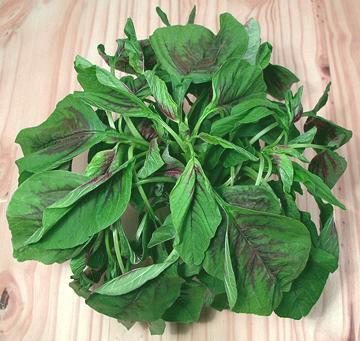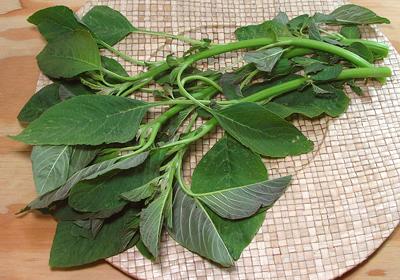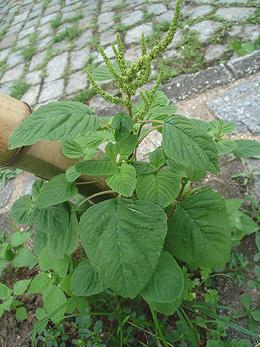There are at least 70 species of Amaranth, and many of them are eaten to at least some extent in various parts of the world. Listed here are species most likely to be encountered in North America, which are also the most common worldwide. For seeds see our Amaranth Seeds page.
 [Chinese spinach; Red Spinach (markets); Pak khom (Thai);
Kilitis, Kulitis, Kalunay (Philippine); Chua, Chaulai, Harive, Cheera
(India); Bayam (Malaysia); Hinn Choy, Hen Choy, Yin Tsoi (China),
A. dubius, A. tricolor]
[Chinese spinach; Red Spinach (markets); Pak khom (Thai);
Kilitis, Kulitis, Kalunay (Philippine); Chua, Chaulai, Harive, Cheera
(India); Bayam (Malaysia); Hinn Choy, Hen Choy, Yin Tsoi (China),
A. dubius, A. tricolor]
Originating in South or Southeast Asia, these Amaranth greens are now grown and eaten through much of the world. The photo specimens were obtained from a market in Los Angeles (Alhambra) serving a mixed Vietnamese / Chinese community, but it is also very popular in parts of India, Sri Lanka and the Caribbean. It is similar to spinach in use but not as fragile so it accepts rougher handling and longer cooking times. In addition to being a lot less tart, it's somewhat mucilaginous so it has a thickening effect.
Amaranth roots are also nutritious, and used in soups in China, Vietnam and Nigeria, but are not found in North American markets. Greens and roots have significant medicinal uses.
More on Amaranths.
 [Quelite Quintonil (Mexico); Green (Nigeria); Efo Tete,
Tete eleegun (Yoruba); Aleho, Allayahu (Hausa); Inine (Igbo);
Common Amaranth, Red-root Amaranth, Redroot Pigweed;
Amaranthus hybridus syn. Amaranthus retroflexus]
[Quelite Quintonil (Mexico); Green (Nigeria); Efo Tete,
Tete eleegun (Yoruba); Aleho, Allayahu (Hausa); Inine (Igbo);
Common Amaranth, Red-root Amaranth, Redroot Pigweed;
Amaranthus hybridus syn. Amaranthus retroflexus]
Originating in the tropical Americas, these Amaranth greens are now grown and eaten through much of the world's tropics. They are one of the most popular greens in West Africa. The photo specimens were purchased from a market in Los Angeles (Burbank) specializing in Mexican, Central American and South American foods. The bunch was about 15 inches long and weighed 12 ounces. Yield of edible leaves was 4-1/4 ounces (34%).
More on Amaranths.
 [Slender Amaranth; Cheng-kruk (Manipur, India); Kuppacheera
(Karala, India); Note Shak (Bengal); Tanduliya (Sanskrit);
Callaloo (Jamaica (name used for other greens elsewhere)); Massaagu
(Maldives); Amaranthus viridis]
[Slender Amaranth; Cheng-kruk (Manipur, India); Kuppacheera
(Karala, India); Note Shak (Bengal); Tanduliya (Sanskrit);
Callaloo (Jamaica (name used for other greens elsewhere)); Massaagu
(Maldives); Amaranthus viridis]
This widely distributed plant is an important culinary green in South Asia (India, Maldives, Bangladesh) and Africa. The seeds are also used in those regions, and are easier to harvest than those of most Amaranths. They have a nutty taste and are used as snacks, in biscuits and porridges. Photo by Eurico Zimbres distributed under license Creative Commons Attribution-ShareAlike v3.0 Unported.
More on Amaranths.
The American Amaranth greens are still difficult to find, but are available in some Hispanic specialty markets.